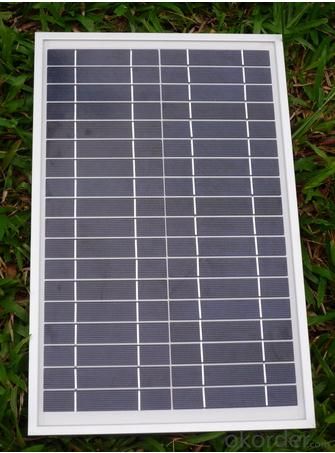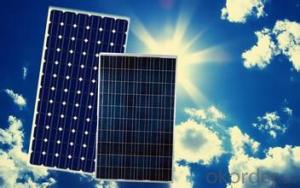66KW CNBM Monocrystalline Silicon Panel for Home Using
- Loading Port:
- Tianjin
- Payment Terms:
- TT OR LC
- Min Order Qty:
- 50 watt
- Supply Capability:
- 1000 watt/month
OKorder Service Pledge
OKorder Financial Service
You Might Also Like
Item specifice
66KW CNBM Monocrystalline Silicon Panel for Home Using
Production description
Solar energy is radiant light and heat from the Sun harnessed using a range of ever-evolving technologies such assolar heating, photovoltaics, solar thermal energy, solar architecture and artificial photosynthesis.
It is an important source of renewable energy and its technologies are broadly characterized as either passive solar oractive solar depending on the way they capture and distribute solar energy or convert it into solar power. Active solar techniques include the use of photovoltaic systems
Off-the-grid homes are autonomous; they do not rely on municipal water supply, sewer, natural gas, electrical power grid, or similar utility services. A true off-grid house is able to operate completely independently of all traditional public utility services. The idea has been recently popularized by certain celebrities including Ed Begley, Jr.[1] who stars in Living with Ed[2] television show on the Home & Garden Television (HGTV) network. Actress Daryl Hannahpromotes off-grid living and constructed her home in Colorado according to those principles, as does survival expert and Dual Survival co-star Cody Lundin,[3]who lives in a self-designed, passive solar earth house in the high-desert wilderness of Northern Arizona, collecting rainwater, composting waste, and paying nothing for utilities.[4][5]
The large magnitude of solar energy available makes it a highly appealing source of electricity. The United Nations Development Programme in its 2000 World Energy Assessment found that the annual potential of solar energy was 1,575–49,387 exajoules (EJ). This is several times larger than the total world energy consumption, which was 559.8 EJ in 2012.

Feature
1.High conversion efficiencies resulting in superior power output performance.
2.Outstanding power output even in low light or high temperature conditions
3.Optimized design for ease of soldering and lamination
Physical characteristic
1. Rigorous quality control meets the highest international standards.
2. High-transmissivity low-iron tempered glass, strong aluminium frame.
3. Using UV-resistant silicon.
4. IS09001/14001/CE/TUV/UL
Packaging
26pcs in one carton 6pallets in 20foot container 14pallets in 40 foot container.
- Q:Can solar energy systems be used in powering wineries or breweries?
- Yes, solar energy systems can definitely be used to power wineries or breweries. In fact, many wineries and breweries around the world have already embraced solar power as a sustainable and cost-effective energy source. Solar energy systems can be installed on the rooftops or surrounding areas of these facilities to capture sunlight and convert it into electricity. The electricity generated from solar panels can be used to power various aspects of winemaking or brewing operations, such as lighting, heating, cooling, and machinery. It can also be used to run pumps for irrigation or ventilation systems, which are crucial for maintaining the ideal conditions for the fermentation process. Using solar power not only helps wineries and breweries reduce their carbon footprint and dependence on fossil fuels but also offers several financial benefits. Solar energy systems can significantly lower utility bills, as wineries and breweries often require a substantial amount of electricity to operate. Additionally, some regions offer incentives and tax credits for businesses that adopt renewable energy sources like solar power. Moreover, solar energy systems can provide wineries and breweries with energy independence and reliability. They can generate electricity even during power outages or during peak demand periods when electricity prices are higher. This ensures uninterrupted production and reduces the vulnerability of these facilities to energy shortages or price fluctuations. Overall, solar energy systems have demonstrated their effectiveness in powering wineries and breweries, offering environmental, financial, and operational advantages. By harnessing the power of the sun, these industries can contribute to a more sustainable future while enjoying the numerous benefits of solar energy.
- Q:Can a solar energy system be installed on a ground mount?
- Yes, a solar energy system can be installed on a ground mount. In fact, ground-mounted solar systems are quite popular and offer several advantages over roof-mounted systems. Ground-mounted systems are typically larger in size and can accommodate more solar panels, allowing for greater energy production. They can also be installed at the optimal angle and orientation for maximum sunlight exposure, which may not always be possible on a roof. Additionally, ground-mounted systems are easier to access for maintenance and cleaning, as they are not located on the roof. Therefore, if you have sufficient space available on your property, a ground-mounted solar energy system can be an excellent option for generating clean and renewable energy.
- Q:What is the lifespan of solar energy inverters?
- The lifespan of solar energy inverters typically ranges from 10 to 20 years, depending on various factors such as the quality of the inverter, usage conditions, maintenance, and technological advancements.
- Q:Are there any tax credits available for installing solar energy systems?
- Yes, there are tax credits available for installing solar energy systems. The federal government offers the Investment Tax Credit (ITC), which provides a credit of 26% of the total cost of the solar system installed. Some states also offer their own tax credits, incentives, or grants for solar installations. It is advisable to consult a tax professional or contact local authorities to determine the specific credits available in your area.
- Q:Are there any risks of electromagnetic radiation with solar energy systems?
- Yes, there are potential risks of electromagnetic radiation associated with solar energy systems. Solar energy systems use photovoltaic (PV) panels to convert sunlight into electricity. These panels generate direct current (DC) electricity, which is then converted into alternating current (AC) electricity for use in our homes and businesses. One potential source of electromagnetic radiation is the inverter, which is responsible for converting DC electricity into AC electricity. In some cases, these inverters can produce electromagnetic fields (EMFs) that may emit low-frequency radiation. While these EMFs are generally considered to be low and within acceptable limits, there is ongoing research to better understand any potential health effects associated with long-term exposure to these fields. Another potential risk is the presence of high-frequency electromagnetic radiation from radio frequency (RF) communication devices, such as wireless monitoring systems or communication modules used in solar energy systems. These devices transmit and receive signals wirelessly, and there is some concern about the potential health effects of long-term exposure to RF radiation. However, the power levels of these devices are generally low, and they are designed to comply with safety standards and regulations. It is important to note that the risks associated with electromagnetic radiation from solar energy systems are generally considered to be low compared to other sources of electromagnetic radiation in our everyday lives, such as cell phones, Wi-Fi routers, or power lines. Nonetheless, it is always recommended to follow safety guidelines provided by manufacturers and industry standards to minimize any potential risks.
- Q:Can solar energy systems be used for powering remote monitoring equipment?
- Yes, solar energy systems can be used for powering remote monitoring equipment. Solar energy systems use photovoltaic (PV) panels to convert sunlight into electricity, which can then be used to power various devices and equipment. Remote monitoring equipment, such as weather stations, surveillance cameras, or communication systems, can be easily powered by solar energy systems. These systems are particularly useful in remote or off-grid locations where access to electricity may be limited or non-existent. Solar energy is a sustainable and renewable source of power, making it an ideal choice for powering remote monitoring equipment without relying on fossil fuels or traditional electrical grids. Additionally, solar energy systems can often be combined with battery storage to provide continuous power supply even during periods of low sunlight.
- Q:Can a solar energy system be installed in areas with low sunlight?
- Yes, a solar energy system can be installed in areas with low sunlight. While it is true that solar panels rely on sunlight to generate electricity, advancements in technology have made it possible for solar systems to still produce energy even in areas with limited sunlight. In regions with low sunlight, solar panels can still capture and convert available sunlight into usable energy. Additionally, some solar systems are designed to optimize energy production by utilizing tracking systems that allow the panels to follow the sun's path throughout the day, maximizing the amount of sunlight they receive. Furthermore, energy storage solutions such as batteries can be incorporated into the solar system, allowing for the storage of excess energy generated during periods of higher sunlight for use during times of lower sunlight. These advancements in solar technology have made it feasible to install solar energy systems in areas with low sunlight, providing clean and renewable energy options to a wider range of regions.
- Q:Can a solar energy system be installed on a building with a flat roof?
- Yes, a solar energy system can be installed on a building with a flat roof. Flat roofs provide an ideal surface for mounting solar panels, as they offer a level surface and provide ample space for installation. Furthermore, flat roofs often have unobstructed sun exposure, which is crucial for maximizing the efficiency of solar panels.
- Q:Are there any risks of electrical shock with solar energy systems?
- Yes, there are potential risks of electrical shock associated with solar energy systems. While solar panels themselves do not produce dangerous voltages, the electrical wiring and components used in the system can carry high voltages that may pose a risk if not handled correctly. It is crucial to have trained professionals install and maintain solar systems to ensure proper grounding, insulation, and safety precautions are in place, reducing the risk of electrical shock to a minimum.
- Q:Are there any risks of electrical malfunction or failure with solar energy systems?
- Solar energy systems come with certain risks of electrical malfunction or failure. One of the primary concerns revolves around faulty or damaged electrical connections, which can cause a loss of power generation or even spark electrical fires. Moreover, extreme weather conditions like lightning strikes or strong winds have the potential to harm solar panels or inverters, resulting in either temporary or permanent system failure. Another issue lies in the gradual degradation of solar panels over time, leading to reduced efficiency and eventual replacement. Furthermore, inadequate installation or maintenance practices may contribute to system failure or electrical malfunctions. To mitigate these risks, it is crucial to have solar energy systems installed by qualified professionals and ensure regular inspections and maintenance are conducted.
1. Manufacturer Overview |
|
|---|---|
| Location | |
| Year Established | |
| Annual Output Value | |
| Main Markets | |
| Company Certifications | |
2. Manufacturer Certificates |
|
|---|---|
| a) Certification Name | |
| Range | |
| Reference | |
| Validity Period | |
3. Manufacturer Capability |
|
|---|---|
| a)Trade Capacity | |
| Nearest Port | |
| Export Percentage | |
| No.of Employees in Trade Department | |
| Language Spoken: | |
| b)Factory Information | |
| Factory Size: | |
| No. of Production Lines | |
| Contract Manufacturing | |
| Product Price Range | |
Send your message to us
66KW CNBM Monocrystalline Silicon Panel for Home Using
- Loading Port:
- Tianjin
- Payment Terms:
- TT OR LC
- Min Order Qty:
- 50 watt
- Supply Capability:
- 1000 watt/month
OKorder Service Pledge
OKorder Financial Service
Similar products
New products
Hot products
Related keywords



























